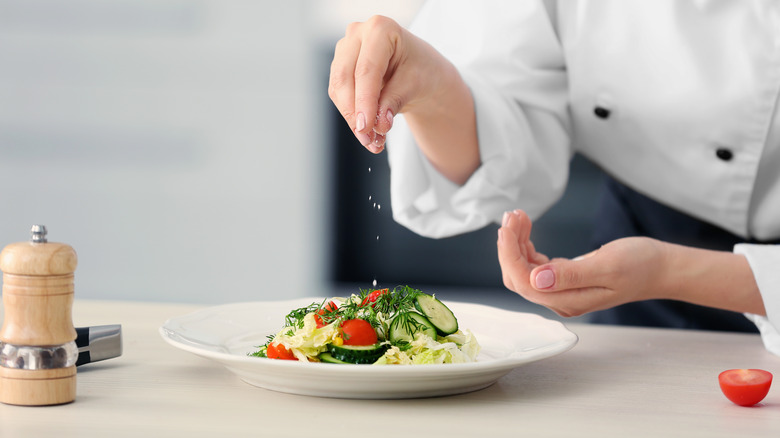How Is Sel Gris Different From Regular Sea Salt?
All salts are not created equal, and particular varieties of salt can be used in different ways. You may have come across a jar of salt called sel gris and wondered how it differs from regular sea salt.
Sel gris (gray salt) is a form of French sea salt called fleur de sel. Fleur de sel is a flaky salt made by evaporating seawater in special solar evaporation ponds or pans. As the water dries, the flaky salt left behind is carefully hand harvested in order to preserve its pristine white color. Sel gris is made the same way, but it is the lower layer of salt that touches the clay bottom of the ponds or pans, which gives it its distinctive gray color and a slightly more mineral taste.
Sel gris can sometimes be sold as Celtic sea salt, and it can be left in its large flaky form or processed into a finer salt. It's also what is known as an unrefined salt, meaning that it's made from natural sources with no other additives or preservatives. Now that you know what sel gris is, it's time to move on to the fun stuff — how it can be used.
Use sel gris as a finishing salt
One of the easiest ways to use sel gris is by simply sprinkling it over a dish right before you serve it. When used in this way, it's known as a finishing salt, and it can really help flavors pop, while also introducing textural differences to the dish. Try sprinkling a pinch or two of sel gris over a salad as you get ready to serve it. Embrace your inner Salt Bae and shower some over a sizzling steak right off the grill. To really show off the sel gris, pack some softened, unsalted butter into a small crock, sprinkle a bit of the salt on top of the softened butter, and serve with bread and quartered radishes.
By using the sel gris as a finishing salt, you can highlight its unique color and distinctive taste, as opposed to just mixing the salt into a sauce or baked dish. You can even put a small ramekin or bowl of sel gris right on the dinner table and invite your guests to grab a pinch or two themselves.
Make a stunning sel gris salt baked fish
Another way to use sel gris is in a salt-baked fish preparation, like the one Gordon Ramsay cooks. Ramsay uses a sea bream, but this surprisingly easy recipe can be made with almost any whole fish. You'll need quite a bit of sel gris, so save this dish for a special occasion.
Start by cleaning and preparing your fish. You can stuff the cavity of your fish with your choice of herbs, and adding some citrus slices (lemon, lime, or even orange) is always a good idea. Put a layer of sel gris onto the bottom of a baking dish and then place the fish on top of the salt. Proceed to encase the entire fish in more sel gris, until it's completely covered. You can wet the salt with a bit of water to make it stick, but really pack it down to create an almost-air tight crust over the fish. Bake the fish in the oven at 350 F for about 25 minutes per pound of fish. When the fish is done, carefully bring the whole thing to the table, cracking open the salt crust and serving the fish right from the dish for a stunning meal.
Use sel gris in desserts
Sel gris can also be used in desserts. If you plan on substituting sel gris for the traditional sea salt that a cake recipe may call for, you'll need to keep in mind that it weighs a bit differently from other salts. MasterClass did a breakdown of salt weights, but if you tend to use Diamond Crystal Kosher salt you'll want to use slightly less sel gris in the recipe as it weighs a bit more. Conversely, if you often use Morton's sea salt, you'll want to use a bit more sel gris as Morton's is heavier.
An easier way to use sel gris in desserts is to revisit the finishing method. When used lightly, salt can actually make sweet things taste sweeter. Try sprinkling sel gris over a bowl of ice cream or onto a slice of cake. When baking a pie, scatter a bit of sel gris on top of the crust before it goes into the oven. And you can really elevate brownies by sprinkling some sel gris over the bottom of your baking dish before pouring brownie batter in. Once cooled and cut, the sel gris on the bottom of the brownie actually hits your tongue first for a burst of flavor. Though sel gris is usually found at high-end grocery stores and online, now that you know the various ways it can be used, it might be worth adding it to your salt repertoire.



